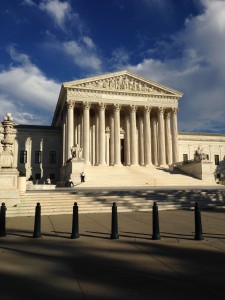It is not that often that an agricultural law issue is before the United States Supreme Court. Yesterday, however, the Court sided with raisin farmers who claimed that a government ag marketing order constituted a taking of their private property for which just compensation was owed. [Read full opinion here.]
Factual Background
This case involves a claim by the Horne family against the United States Department of Agriculture. The Hornes are raisin farmers and raisin growers in California. In addition to raising their own raisins, they serve as sort of a middle-man, where other farmers deliver their raisins to be packed and sold.
Under the Agricultural Marketing Agreement Act, the Secretary of Agriculture is permitted to issue “marketing orders” for particular agricultural products. The purpose of these orders is to help the government maintain stable markets for these products. The Raisin Marketing Order requires growers to give a certain percentage of their raisin crop to the government in certain years free of charge. The percentage that must be given is decided by the Raisin Administrative Committee (“RAC”), appointed by the Secretary of Agriculture. The percentages vary each year. For example, in 2002-2003, the order required growers to give up 47% of their crop, which in 2003-2004, the order required growers to give up 30%.
Thus, when raisins are delivered to a handler, such as the Hornes, the handler generally separates the percentage of raisins allocated to the government (“reserve raisins”) from the remainder of the growers’ crops (“free-tonnage raisins”). Generally, the raisin farmers are paid only on the free-tonnage raisins. The RAC then acquires title to the reserve raisins and sends trucks to pick up the raisins from the handlers. From there, the RAC has discretion to do what it determines best with the raisins, such as selling them into non-competitive markets, donating them to charity, or destroying them. The raisin farmers retain an interest in the proceeds from any sale of reserve raisins, but oftentimes once costs are deducted, there are no such proceeds to be distributed to growers.
In 2002, the Hornes refused to set aside any raisins for the government. When the government trucks arrived at the Hornes’ facility to pick up the reserve raisins, they would not allow entry to the facility. The USDA then issued a fine to the Hornes ($480,000 market value for the reserve raisins and $200,000 penalty for disobeying a government order).
In response, the Hornes filed suit claiming that the marketing order resulted in an unconstitutional taking of their property under the Fifth Amendment. The Court of Appeals for the Ninth Circuit sided with the USDA, finding that no taking occurred. The court reasoned this was a regulatory Nolan/Dolan taking and that the government’s imposed condition was a proportional response to the governmental interest in maintaining an orderly raisin market. Further, the court explained, the Hornes could have avoided the government condition by planting a different crop.
Basic Takings Law Background
The sole legal claim at issue in this case is a takings claim under the Fifth Amendment of the Constitution, which provides that the government may not take private property for public use without just compensation. There are essentially two categories of takings: per se (also called categorical takings) and regulatory takings. A per se taking occurs when there is a physical appropriation of property. In that instance, no further analysis into the facts surrounding the case is required, a taking has occurred. A regulatory taking, on the other hand, occurs when a regulation that restricts the use of property goes too far. What constitutes “too far” is determined on a case-by-case, factual basis.
United States Supreme Court Opinion
The Supreme Court specifically considered three issues on appeal: (1) Does the government’s duty to pay just compensation when it physically takes possession of an interest in property apply only to real property and not to personal property?; (2) May the government avoid the duty to pay compensation for a physical taking of property by reserving to the property owner an contingent interest in the value of the property, set at the government’s discretion?; and (3) Does the government’s mandate to relinquish certain identifiable property as a ‘condition’ on permission to engage in commerce constitute a per se taking? Let’s consider each in turn.
(1) Is compensation required for a taking of personal property? The Supreme Court answered in the affirmative. The Court explained there is no dispute that in the case of real property, the Constitution requires just compensation. “Nothing in the text or history of the Takings Clause, or our precedents, suggests that the rule is any different when it comes to appropriation of personal property. The Government has a categorical duty to pay just compensation when it takes your car, just as when it takes your home.”
(2) Does allowing the grower to retain a contingent interest in a portion of the value avoid compensation owed? The Supreme Court said it did not. The Court explained that the reserve requirement constituted a “clear physical taking.” The court reasoned that the raisins are physically separated from the free-tonnage raisins, title passes to the Raisin Committee, and the committee disposes of raisins as it wishes to. This constitutes a per se, not a regulatory, taking. Importantly, the Court drew a distinction here between per se and regulatory takings. For a per se taking, it is unnecessary to consider the potential economic impact on the property owner–only whether or not a physical taking occurred. If, however, this case involved a regulatory taking, then such factors such as economic impact could be considered by the Court. However, because the court found this case to clearly be a per se taking, no such factual analysis was proper.
(3) Did the governmental mandate to relinquish specific property constitute a per se taking? In this case, the Supreme Court said it did. The government argued that the Hornes voluntarily chose to participate in the raisin market and, if they did not like the reserve requirement, they could have raised a different crop or sold their grapes for juice or wine. The Court rejected this argument.
Lastly, the Court considered how compensation should be calculated. The USDA argued that compensation should be figured based upon what the value of the raisins would have been without the price support program. The Court rejected this argument, stating that the measure of just compensation in takings cases is the fair market value of the property at the time of the taking. The government, itself, calculated the fair market value of the raisins when it fined the Hornes $480,000–market value at the time for the raisins.
Thomas Concurring Opinion
In an interesting concurring opinion (meaning that he agreed with the result of the case, but wrote separately to address particular reasoning for the decision), Justice Thomas questioned whether the RAC’s conduct meets the “public use” requirement of takings law. In order for the government to take private property, it must be done for a public use. Justice Thomas states that it is “far from clear” that the RAC taking raisins from growers and giving them away or selling them to exporters, foreign importers, or foreign governments constitutes a public use.
Breyer Opinion
Justice Breyer, along with Justice Ginsburg and Kagen, issued an opinion concurring in part and dissenting in part. Justice Breyer agreed with the Court’s answers to the three questions presented, but opined that the case should be remanded to the lower court to determine the proper measure of just compensation owed to the Hornes. Specifically, he explained, “The marketing order may afford just compensation for the takings of raisins that it imposes.” He reasons that because the reserve requirement is intended to enhance the price of free-tonnage raisins that the growers are able to sell, the proper compensation may be to determine the value of the reserve raisins and deduct any enhancement caused by the taking to the free-tonnage raisins, and award the Hornes the difference. Because this issue was not considered below or briefed by the parties, he would remand the case to determine just compensation.
Sotomayor Dissenting Opinion
Sotomayor is the lone justice who would find that the marketing order did not constitute a per se taking. She believes that in order for a per se taking occurs, the law requires “each and every property right be destroyed by governmental action before the action can be said to have effected a per se taking.” In her dissent, she argues that if any property right is retained by the owner, no physical taking has occurred. Because the Hornes retained the contingent interest in the proceeds of the raisins, she would find no per se taking occurred.
What Can We Learn?
First, this case provides a great distinction between the legal analysis undertaken when dealing with a per se taking versus that undertaken when dealing with a regulatory taking. If a per se physical taking exists, there are no other factual circumstances considered by the courts. On the other hand, if a regulatory taking occurs, numerous factual circumstances and considerations come into play to determine if the regulation “goes too far.”
Second, in this case, 8 of the 9 justices (all but Sotomayor) agree that a per se taking did occur. Thus, the argument that the marketing order, instead, constituted a regulatory taking, was not popular among the justices.
Third, Justice Thomas’ concurrence raises an interesting issue of whether taking the raisins and giving or selling them to foreign countries is actually a public use. This is at least tangentially related to an argument we saw Texas landowners make before Texas Courts with regard to the Keystone Pipeline. Many landowners argued that allowing Keystone–a foreign corporation–to take American land to build a pipeline was improper because the benefit was to a foreign corporation. Texas courts rejected this assertion, but would Justice Thomas have thought differently?
Fourth, Justice Breyer’s opinion is also interesting. Generally, just compensation is based upon fair market value of the property, end of story. But Justice Breyer’s opinion and looks at the issue of whether the market value for the property taken should be off-set where the government gives something of value to the property owner in return. Will this be something he can garner support for in future takings cases?
Finally, the big question for the USDA going forward is what will happen to this type of marketing order? Some farmers favor such marketing orders because of the stabilization and support they believe the orders provide to the market. Others agree with the Hornes and believe such orders are not only unnecessary, but unconstitutional. How broadly will this case be interpreted and what long-term impact will it have? That remains to be seen. Capital Press reports that there are 20 similar USDA marketing orders for other crops, although the exact language and requirements vary by order and crop. [Read article here.] It is unclear whether the Horne opinion will impact these other orders as well.












